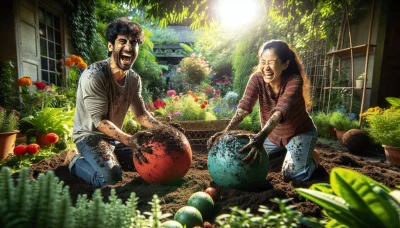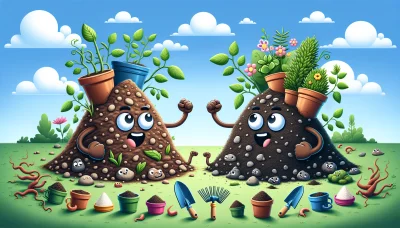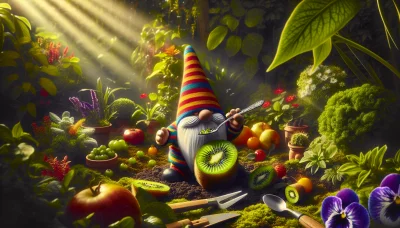Faux Rock Recipe Tutorial Quiz
Test Your Knowledge
Question of
Faux Rock Recipe Tutorial for Garden Enthusiasts
Creating faux rocks for gardening is a fantastic way to enhance the aesthetic appeal of your garden without the hefty price tag and logistical challenges of real rocks. This tutorial is designed to guide garden enthusiasts through the process of making lightweight, durable faux rocks that can be customized in size, shape, and color to fit any garden theme or design. Not only do these artificial rocks add a natural, rugged beauty to your landscape, but they also offer practical benefits such as soil erosion control, creation of natural-looking garden borders, and provision of unique focal points. Dive into this tutorial to learn how to bring an artistic and functional element to your garden with faux rocks.
Materials Needed for Your Faux Rock
- Wire mesh (to form the shape of the rock)
- Chicken wire (for additional shaping and support)
- Heavy-duty scissors or wire cutters (for cutting the mesh)
- Concrete mix (for the outer layer)
- Mortar mix (for sculpting finer details)
- Water (for mixing with concrete and mortar)
- Buckets (for mixing concrete and mortar)
- Trowel (for applying and shaping concrete and mortar)
- Sponge or cloth (for texturing the surface)
- Paints (for coloring your rock)
- Paintbrushes (for applying paint)
- Sealant (to protect the finished rock)
- Gloves (to protect your hands during work)
- Protective eyewear (to protect your eyes)
- Respirator mask (to avoid inhaling dust)
Step-by-Step Faux Rock Creation Process
- Gather all necessary materials and tools, including concrete mix, water, a mixing tool, paint, and sealant.
- Design your rock shape and size, considering where it will be placed and its purpose.
- Build a base form using chicken wire or hardware cloth to shape your rock. This will serve as the skeleton for your faux rock.
- Mix the concrete according to the manufacturer's instructions, ensuring it's neither too thick nor too runny for application.
- Apply the concrete mix over your base form, using hands or tools to sculpt and shape the rock. Make sure to wear gloves to protect your skin.
- Add textures while the concrete is still wet by pressing tools or natural rocks into the surface to create a realistic look.
- Allow the concrete to cure as per the recommended time, usually 24-48 hours, depending on weather conditions and the thickness of your application.
- Once cured, apply a base coat of paint, choosing colors that mimic real rocks in your desired area.
- Add detailing with various shades of paint to enhance the rock's natural appearance. Use a sponge or brush for best effects.
- Apply a sealant to protect the rock from weather elements and to keep the paint from fading over time.
- Place the faux rock in its designated spot, blending it with the surrounding landscape for a natural effect.
Design Ideas for Your Faux Rocks
Faux rocks can significantly enhance your garden's aesthetic appeal and functionality. These versatile elements can be strategically placed to create natural-looking landscapes, hide unsightly areas, or even serve as unique focal points. Consider nestling faux rocks amongst your garden beds to add texture and depth, or use them to create a rugged border that mimics a natural rock outcrop. Integrating faux rocks around water features, like ponds or fountains, can also amplify the serene, natural vibe of your outdoor space. Additionally, pairing these artificial stones with a variety of plants, from delicate ground covers to robust shrubs, can create intriguing contrasts in color and form, making your garden a captivating visual experience.
Maintenance Tips for Faux Rocks
To keep your faux rocks looking as good as new in the garden, regular maintenance is key. Start by gently cleaning them with a mixture of water and mild detergent, using a soft brush to remove any dirt or debris. Avoid using harsh chemicals or high-pressure washers, as these can damage the surface of the rocks. It's also important to check for and repair any cracks or chips in the rocks to prevent water from seeping in and causing further damage. Additionally, consider applying a UV-resistant sealant to protect the rocks from fading due to sun exposure. With these simple steps, your faux rocks can continue to enhance your garden's beauty for years to come.
Frequently Asked Questions
| Question | Answer |
|---|---|
| What materials are needed to make faux rocks? | Typically, you'll need a mixture of cement, sand, peat moss, and water. Some methods also use fiberglass or wire mesh for added strength. |
| Can I make lightweight faux rocks? | Yes, by incorporating materials like perlite or styrofoam into your mixture, you can create lighter rocks that are easier to move. |
| How do I give my faux rocks a natural look? | Adding natural color pigments to the mixture and shaping the rocks with irregular, asymmetrical forms help achieve a more realistic appearance. Texturizing the surface with tools or real rock impressions also adds to the effect. |
| Are faux rocks durable? | When properly made, faux rocks are quite durable and weather-resistant. Sealing the surface can further protect them from the elements. |
| How can I use faux rocks in my garden? | Faux rocks can be used to create unique landscape features, hide unsightly areas, or serve as garden borders or stepping stones. They can also be customized to house garden lights or as bases for water features. |












